Migrating Forms
What makes a film a successful literary adaptation? Ask a random literate moviegoer, and they're likely to answer that a good film adaptation should be "like the book" (or play). In other words, a successful adaptation is a faithful adaptation. What then is a faithful adaptation? One that follows the story of the original text, of course. It's this fixation on story that prompts the common contention that most great modernist and postmodernist novels, which often either lack a traditional story or integrate story elements with discursive material, are "unfilmable." One possible strategy of adaptation is to "flatten out" the original by simply discarding everything that doesn't move the story along, as in Philip Kaufman and Jean-Claude Carrière's version of The Unbearable Lightness of Being, a conventional 1980s Euro-prestige picture that preserves the novel's plot line while eliding the philosophical digressions and ruminations on love and kitsch that are essential to its meaning. So is it a successful adaptation of Milan Kundera's novel? Well, that depends on what you mean by "successful."
Over the latter half of his career, David Cronenberg has intervened in this tiresome discussion with a series of what have been termed "impossible adaptations." In films like Naked Lunch (1991) and Crash (1996), adaptations of novels once regarded as unfilmable, Cronenberg approaches the problem of adaptation from a different angle. One of these films closely follows the story of its source novel and one does not, but both could be described as successful—and even, after a fashion, faithful—adaptations.
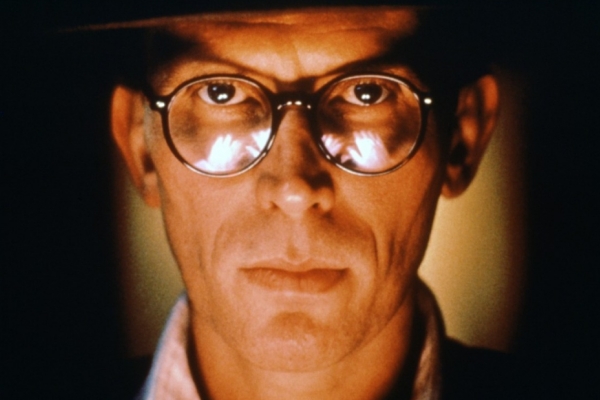
Peter Weller in Naked Lunch
Discussion of adaptations is often haunted by the unresolved question of whether a film should be regarded as merely the extension of a literary work into another form, or as a separate work entirely. Cronenberg's Naked Lunch takes that decision out of the viewer's hands to the extent that it's not really an adaptation of William S. Burroughs's novel at all—at least if adaptation is conceived primarily in terms of story. While most of the movie's major characters and settings (as well as the famous "talking asshole" anecdote) come from the Burroughs novel, it also draws from other Burroughs writings as well as the author's life. Seeing Naked Lunch is in no way a substitute for reading the book, or vice versa—which may be precisely the point.
Talking centipedes and organic typewriters notwithstanding, Naked Lunch is relatively restrained by the standards of Cronenberg's previous work, marking, along with Dead Ringers (1988), a transition between the director's visceral early films and the cooler, more formalist late work. The outré visual effects are played more for laughs than chills. Indeed, Naked Lunch might be Cronenberg's funniest film, beginning with the ironic casting of Robocop himself, Peter Weller, as the alter ego of the outlaw writer. Weller's stone-faced performance positions the film's protagonist, William Lee, as a straight man (pun intended) who takes its bizarre happenings in stride. Recounting a not atypical incident in which his Clark Nova typewriter kills and disembowels a potential rival instrument, Lee deadpans: "I understood writing could be dangerous. I didn't realize the danger came from the machinery."
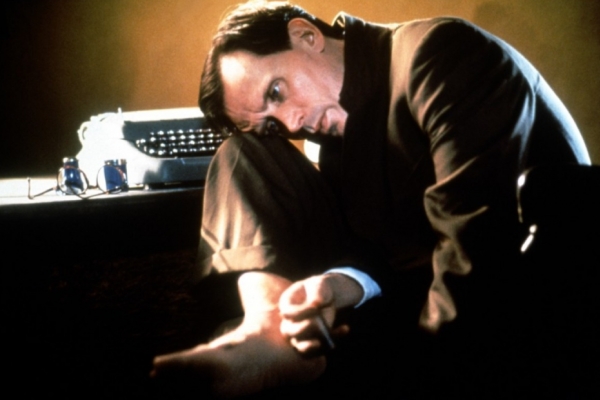
Peter Weller in Naked Lunch
Naked Lunch the film also incorporates aspects of Burroughs's life, particularly the 1951 shooting death in Mexico of his wife, Joan Vollmer Burroughs, in an apparent William Tell accident in which the writer attempted to shoot a tumbler off Joan's head, with the bullet striking her instead. (Burroughs later retracted this story, possibly on the advice of his lawyer, and was eventually convicted in absentia of negligent homicide, receiving a two-year suspended sentence.) The scene plays out not once but twice in Naked Lunch, suggesting its centrality not only to the plot of the film, but to its conception of Burroughs's life and writing career. In an introduction to his novel Queer, written shortly after Joan's death but unpublished for decades, Burroughs would write, "I am forced to the appalling conclusion that I would have never become a writer but for Joan's death." As in real life, there's nothing in the film to suggest the shooting was anything more than a drug-fueled accident, but the question of unconscious intent is left open, particularly in light of an early scene in which a talking centipede instructs Lee to kill Joan, describing her as "an enemy agent"—in other words, as a potential barrier to his work.
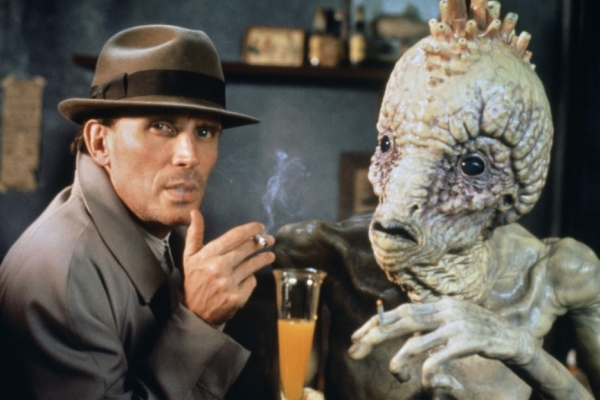
Peter Weller in Naked Lunch
This notion is particularly crucial because the fundamental subject of Cronenberg's Naked Lunch is the nature of the creative process itself. Lee's observation that "writing can be dangerous" recurs throughout the proceedings. Part of that danger comes from its relationship with drug use, which is neither valorized nor condemned. Burroughs's addiction to heroin has been well documented, and both versions of Naked Lunch feature various stand-ins for junk. Lee periodically suffers from the shakes and other withdrawal symptoms, and late in the film, when he's visited by his friends and fellow writers Hank (Nicholas Campbell) and Martin (Michael Zelniker), he can't even remember having written long passages of the novel he's working on, eventually identified as Naked Lunch itself. The text seems to have come to Lee in some narcotic fugue state where he imagines himself to be an agent working for one of the obscure political factions in the Interzone (a setting from the Burroughs novel that appears to correspond with the former real-life "international zone" of Tangier, Morocco). As the Clark Nova tells him, "An unconscious agent is an effective agent."
Cronenberg's film also touches on the ever-elusive link between sexual and creative potency. After Lee has decamped to the Interzone, the Clark Nova informs him that "homosexuality is the best all-around cover that an agent ever had," but later on when we see one of the ubiquitous "Interzone boys" in his bedroom, it's not clear whether Lee's sexuality is a cover for his subversive activities, or if it's the other way around. What is clear is that Lee is finally getting some writing done. The connection is made more explicit in a bizarre setpiece involving a three-way between man, woman, and typewriter (the Clark Nova appears to be endowed with both male and female genitalia). And of course the film's ultimate high, supplanting bug powder and centipede meat, as well as the object of the Interzone's factional infighting, turns out to be mugwump jism (we observe several addicts getting their fix directly from the source in the climactic scene).
These evocations of drug use and polymorphous sexuality fit into a larger conversation about the role of irrational bodily drives in creative work. Very early in the film, Hank and Martin argue about rewriting, which Hank terms "a sin," equating any rethinking of "the flow, the rhythm, the tumbling out of the words" with self-censorship. Defending his own obsessive-compulsive rewriting, Martin insists on a more Cubist aesthetic, citing the need to consider his material "from every possible angle." Cronenberg's Naked Lunch embodies both approaches. While the material added to the novel has the paradoxical effect of making the film more linear in its narrative than the Burroughs book and less a work of the avant-garde, the film does preserve the novel's porous mixture of reality and hallucination without always marking the difference between them, even as it also examines the book from the outside, becoming less a traditional adaptation of the Burroughs novel than a commentary on the book and its writing. So what is the movie's take on the writing process? We might answer, along with Lee: "Exterminate all rational thought."
***
First published, remarkably enough, in 1973, J.G. Ballard's novel Crash details the adventures of a commercial director who, following a serious automobile accident, becomes drawn into a sexual underworld of car-crash fetishists led by a charismatic outlaw scientist named Vaughan. The protagonist's name? James Ballard.
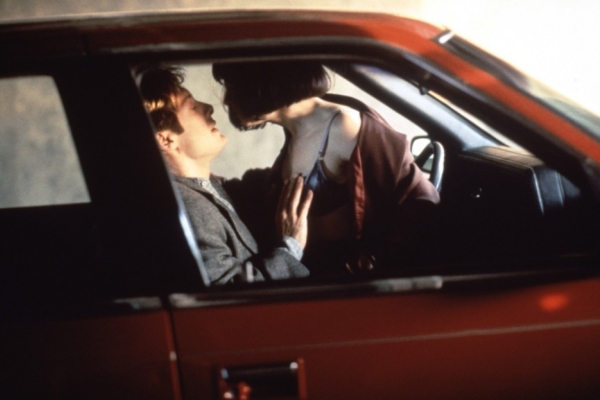
James Spader and Holly Hunter in Crash
Like his Naked Lunch, which preserves the hallucinatory form of its source novel without reproducing much of its plot, Cronenberg's Crash could be termed a formal adaptation. Unlike the earlier film, though, Crash is what's typically called a faithful adaptation, with nearly every major scene in the film having some referent in the Ballard novel. (The only significant exception is the film's ending, which remains very much in the spirit of Ballard's book.) But its faithfulness goes much deeper. Indeed, it's hard to think of a better match of tone between a major contemporary novel and its cinematic adaptation, or of sensibility between an author and filmmaker in contemporary cinema (setting aside cases of direct collaboration, such as the works of Béla Tarr and Lászlo Krasznahorkai). Nearly any discussion of the novel is populated with adjectives like perverse, clinical, and detached—the same vocabulary often used to describe Cronenberg's work. Given this shared sensibility, a faithful adaptation was a foregone conclusion.
Both Ballard and Cronenberg approach the potentially lurid material as nonchalantly as their characters do. Ballard's novel is chock-full of highly explicit, yet dispassionate, descriptions of sexual acts and bodily fluids that are more anatomy textbook than dimestore erotica. Cognizant of the far more visceral effect such material would have onscreen, Cronenberg wisely doesn't attempt to reproduce these descriptions directly (with the exception of one shot of a sticky hand), but achieves similar tonal effects through his direction. The camera often looks down from a slight distance on the characters during the many sex scenes, and the performances are carefully modulated, with the actors speaking in affectless tones throughout, hardly ever raising their voices. The hushed dialogue combines with the insistent chimes of Howard Shore's moody, unsettling guitar score to hypnotic effect.
Crash represents a career peak for most of its cast. James Spader's ironic cool has never been deployed to better effect than as Ballard's alter ego. But it's Elias Koteas, as Vaughan, both the soul and the unrestrained id of Ballard's novel, whose presence dominates the film. Rarely reacting to the other actors, Koteas seems driven by his own internal cues, his hollow eyes simultaneously devoid of emotion and overflowing with a dangerous, insatiable curiosity. Constantly intruding on others' personal space, he's an irrepressible physical presence, both magnetic and repellent. In the film, Vaughan's major project is the re-enactment of celebrity car crashes in minute historical detail. Like William Lee, Vaughan is an artist, and Crash is concerned with his creative process.
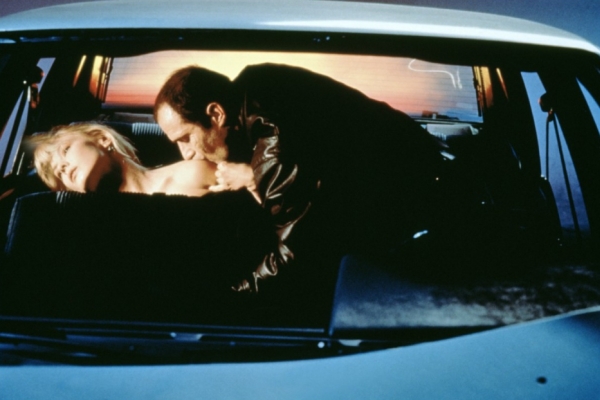
Deborah Kara Unger and Elias Koteas in Crash
As Roger Ebert once put it, Cronenberg is "always filming activities that look like sex, but don't employ any of the appurtenances associated with that pastime." (Naked Lunch provides several cases in point.) In Crash, the sexuality is explicit—including a memorable scene, found in both book and film, in which James penetrates a wound on a woman's thigh—but the camera's erotic gaze is reserved for technology and its corporeal consequences. Repeated shots of cars negotiating the concrete-and-steel geography of ramps and expressways closely track passages from Ballard's novel. Moreover, the camerawork by Peter Suschitzky (the d.p. on every Cronenberg feature since Dead Ringers) embodies the fetishizing gaze of the characters, obsessively caressing the wrecked bodies of cars and staring long and hard at wounded flesh, even as a lengthy sex scene between James and wife Catherine (Deborah Kara Unger) is shot in more conventional fashion, its erotic charge mostly provided by dialogue, as Catherine fantasizes about the possibility of a homosexual encounter between James and Vaughan.
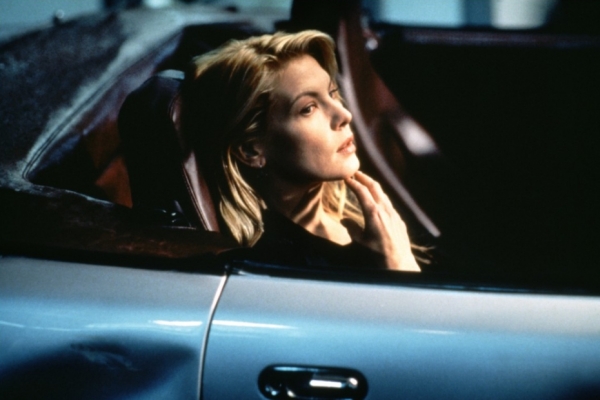
Deborah Kara Unger in Crash
The novel Crash appeared about a decade after the publication of Marshall McLuhan's groundbreaking Understanding Media: The Extensions of Man. As its subtitle suggests, one of that book's key concerns is how technology operates as an extension of human sensory perception: the wheel extends the working of the human foot, television and radio extend the power of our eyes and ears, etc. So far, so good. But McLuhan goes further. Drawing from contemporary medical research, he posits that such extensions are also acts of "autoamputation." To put it in more contemporary parlance, technology enables us to outsource our own bodily functions. Drawing from the myth of Narcissus, McLuhan writes that such acts of self-amputation not only relieve the burden on our central nervous system, thus enabling us to cope with the workload and sensory bombardment of modern life—the stimulus behind technological development in the first place—but also induce a state of numbness:
To behold, use or perceive any extension of ourselves in technological form is necessarily to embrace it. To listen to radio, or to read the printed page is to accept these extensions of ourselves into our personal system and to undergo the "closure" or displacement of perception that follows automatically. It is this continuous embrace of our own technology in daily use that puts us in the Narcissus role of subliminal awareness and numbness in relation to these images of ourselves.
Like Narcissus failing to recognize his own reflection in the water, we fetishize our own image, as mediated by technology, thus absorbing the bombardment of the outside world into our own closed system. In McLuhan's words: "Men at once become fascinated by any extension of themselves in any material other than themselves."
The extension of McLuhan's ideas into the iPhone age is a mere formality, which explains why, just as Crash the novel increasingly looks like one of the key works of late-20th-century Anglophone literature, Crash the film looks more and more like Cronenberg's masterpiece. Vaughan and his disciples—and, crucially, there is no major character in the film who doesn't fall into that category—are just such closed systems who can relate to one another sexually (to say nothing of emotionally) only through technological extensions of themselves, particularly the automobile. Thus, auto-erotica in both senses is very much the subject here. Pondering his and Catherine's wide-ranging sexual fantasies, James reflects in the novel that "these pursuits had begun to make all our relationships, both between ourselves and with other people, more and more abstract....These descriptions seemed to be a language in search of objects, or even, perhaps, the beginnings of a new sexuality divorced from any possible physical expression." In the wake of James's car crash, this new sexuality becomes inextricable from fantasies about technology: "The crash between our two cars was a model of some ultimate and yet undreamt sexual union."
Ultimate is hardly a throwaway adjective here. For the characters in Crash, the autoamputation of their own sexuality and its concomitant displacement onto technology is inextricable from the death drive. The notion of technology as the purveyor of a new sexuality was hardly new to the Cronenberg oeuvre, and the relationship between Eros and Thanatos forms a key undercurrent, finally reaching the surface to put the danger in A Dangerous Method (2011). But while the cry "Long live the new flesh" in Videodrome (1983), embedded in the context of political and social rebellion, could be seen as both cautionary tale and promise of rebirth, Vaughan's new path leads only to death. And so, the film's final scene, not found in the novel: following yet another car crash, this one provoked by James ramming his vehicle into the rear end of Catherine's, he asks if she's hurt, and she answers that she thinks she's all right. As they begin to have sex amid the wreckage, he murmurs, "Maybe the next one, darling. Maybe the next one." ![]()
LATEST ARTICLES
-20140814-173707-thumb3.jpg)
Fighting Words
by Imogen Sara Smith
posted August 12, 2014

Fighting Words, Part 2
by Imogen Sara Smith
posted August 20, 2014

On the Margins: The Fil…
by Andrew Chan
posted August 12, 2014

Robin Williams: A Sense…
by David Schwartz
posted August 12, 2014
 Migrating Forms
Migrating Forms
KEYWORDS
David Cronenberg | adaptation | Naked Lunch | William S. Burroughs | sexuality | Crash | J.G. Ballard | technologyRELATED ARTICLE
Physical Instincts by Gina TelaroliThey Came From Within by Miriam Bale
Laws of Desire by Tom McCormack
More: Article Archive
THE AUTHOR
Joshua Land is a freelance writer and a founding co-editor of the online literary journal Essays & Fictions. He is currently studying applied economics at the University of Wisconsin-Madison.
More articles by Joshua LandAuthor's Website: Pop Tones

